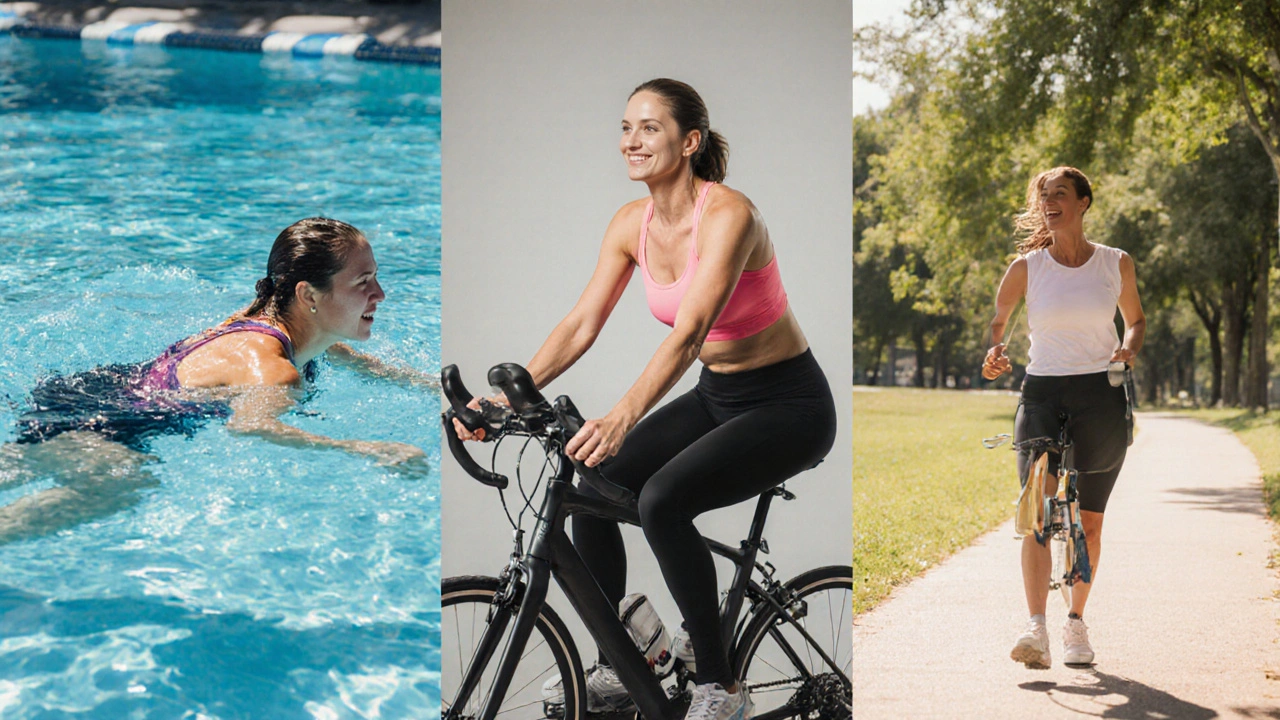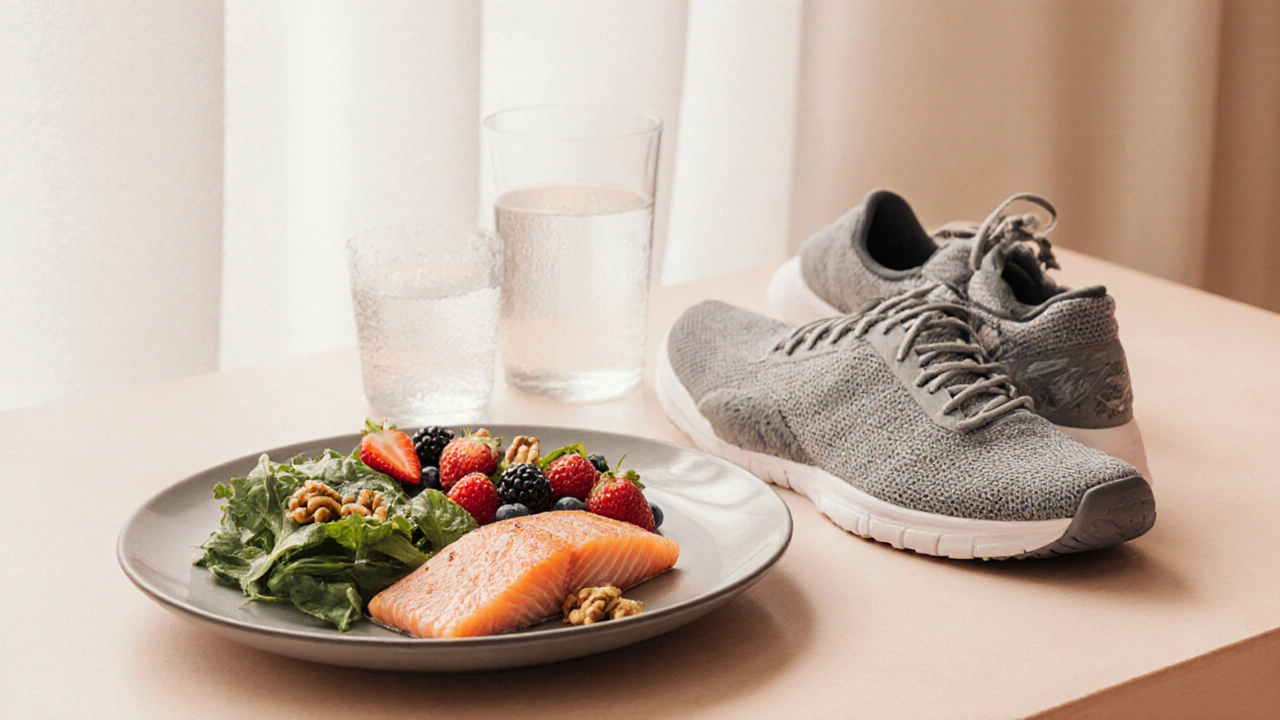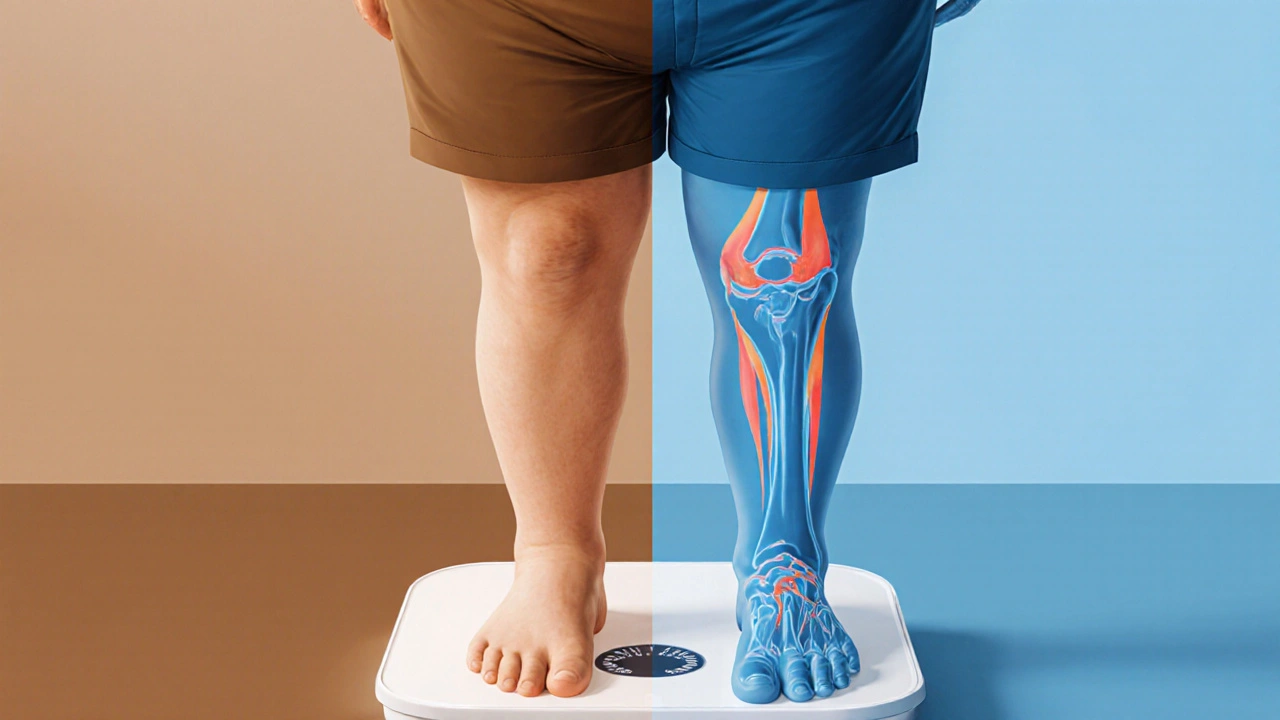Osteoarthritis Risk Assessment
Assess Your Risk Factors
Answer the following questions to get a personalized risk assessment for osteoarthritis.
Your Risk Assessment
- Regular low-impact exercise like swimming or cycling
- Maintaining a healthy weight
- Eating a diet rich in omega-3s and antioxidants
- Staying hydrated and avoiding prolonged inactivity
Quick Takeaways
- Maintain a healthy weight to reduce stress on weight‑bearing joints.
- Incorporate low‑impact exercises like swimming or cycling at least three times a week.
- Eat a diet rich in omega‑3 fatty acids, vitamin D, and antioxidants to support cartilage.
- Stay hydrated and avoid prolonged periods of inactivity.
- Seek professional advice early if you notice joint pain or stiffness.
Understanding Osteoarthritis
When talking about joint health, Osteoarthritis is a degenerative joint disease that gradually wears down cartilage, the smooth tissue that cushions bones. As cartilage thins, bones rub together, causing pain, swelling, and reduced mobility. It most commonly affects the knees, hips, hands, and spine, and risk rises with age, genetic factors, and joint injuries.
Key risk factors include:
- Age over 45
- Excess body weight
- Previous joint trauma
- Genetic predisposition
- Chronic inflammation
Knowing what drives the disease helps you target the right prevention strategies.
Key Lifestyle Factors
Three lifestyle pillars have the biggest impact on joint health: weight management, movement, and nutrition.
Weight is the amount of mass carried by the body, influencing the load placed on joint surfaces. Even a modest 5% weight loss can cut knee joint load by up to 40%.
Exercise is the second pillar. Exercise is any bodily activity that elevates heart rate, strengthens muscles, or improves flexibility. Regular movement maintains synovial fluid circulation, which nourishes cartilage.
Finally, diet fuels repair. Diet is the pattern of food and drink consumption that provides nutrients for bodily functions rich in anti‑inflammatory compounds supports cartilage integrity and reduces pain.

Exercise Strategies for Joint Protection
Not all workouts are created equal when it comes to joint health. Low‑impact activities keep the joints moving without the pounding that accelerates wear.
| Aspect | Low‑Impact | High‑Impact |
|---|---|---|
| Joint Stress | Minimal | High |
| Typical Activities | Swimming, cycling, elliptical, walking | Running, jumping, high‑intensity interval training |
| Calorie Burn (30min) | 200-300kcal | 300-500kcal |
| Suitability for Beginners | Excellent | Moderate to low |
Incorporate a mix of aerobic, strength, and flexibility work. A sample weekly plan could look like:
- Monday: 30minutes swimming (aerobic)
- Wednesday: 20minutes body‑weight squats, lunges, and core work (strength)
- Friday: 30minutes brisk walking + 10minutes stretching (flexibility)
- Saturday: Light cycling or a yoga class
Consistent, varied movement keeps the synovial fluid circulating, delivering nutrients to cartilage is the resilient connective tissue that covers bone ends in joints and removes waste products.
Nutrition & Supplements
While no food can fully stop joint degeneration, certain nutrients target the biological pathways that lead to cartilage loss.
- Omega‑3 fatty acids (found in fatty fish, flaxseed, walnuts) help reduce inflammation is the body's immune response that can damage joint tissues when chronic, a key driver of osteoarthritis pain.
- Vitamin D supports bone health; low levels are linked to faster cartilage breakdown.
- Glucosamine & chondroitin are naturally occurring compounds in cartilage; supplements may modestly improve joint comfort for some people.
- Antioxidant‑rich foods (berries, leafy greens, teas) combat oxidative stress, another contributor to cartilage aging.
Aim for at least two servings of oily fish per week, a daily handful of nuts, and a colorful plate of vegetables. If dietary intake falls short, discuss supplement options with a healthcare professional.
Protecting Cartilage & Reducing Inflammation
Staying hydrated is a simple yet often overlooked habit. Water makes up about 80% of synovial fluid, the lubricant that reduces friction between joint surfaces.
Mindful choices like swapping processed snacks for fresh fruit can cut down on inflammatory triggers such as excess saturated fats and refined sugars.
Cold packs after intense activity can also limit acute inflammation, while gentle heat before stretching improves tissue elasticity.

Everyday Habits That Preserve Joint Health
Beyond workouts and meals, daily routines play a big role:
- Posture: Keep spine alignment neutral while sitting; use ergonomic chairs and consider a lumbar roll.
- Footwear: Choose shoes with good arch support and cushioning, especially for standing or walking jobs.
- Breaks: Stand up and move for a few minutes every hour if you have a desk‑bound job.
- Weight‑bearing activities: If you lift heavy objects, use your legs, not your back, and keep loads close to your body.
These small adjustments reduce abnormal joint loading and keep the cartilage from being over‑stressed.
When to Seek Professional Help
If you notice persistent joint pain, stiffness lasting more than 30minutes after rest, or swelling, it’s time to see a clinician. Early evaluation can identify mild osteoarthritis before it progresses.
Physical therapy is a treatment approach that uses targeted exercises, manual techniques, and education to improve movement and reduce pain often serves as the first line of defense. Therapists can tailor a program based on your specific joints and activity level.
In some cases, doctors may prescribe anti‑inflammatory medication, corticosteroid injections, or discuss surgical options if joint damage is severe.
Joint‑Health Checklist
- Maintain a BMI<25 (or as advised by your doctor).
- Engage in low‑impact aerobic activity ≥150minutes weekly.
- Do strength training for major muscle groups twice a week.
- Include omega‑3 rich foods, vitamin‑D sources, and antioxidants daily.
- Drink at least 2liters of water each day.
- Practice good posture and use supportive footwear.
- Take regular movement breaks during sedentary work.
- Consult a healthcare professional at the first sign of persistent joint discomfort.
Following this checklist can help you prevent osteoarthritis and keep joints feeling supple for years to come.
Frequently Asked Questions
Can I completely stop osteoarthritis from developing?
You can’t guarantee it won’t ever appear, especially if you have a strong genetic predisposition. However, adopting the lifestyle habits outlined above dramatically lowers your risk and can delay onset.
Is running bad for my knees?
Running is a high‑impact activity, so it puts more repetitive stress on knee cartilage. If you love running, balance it with strength training, proper shoes, and occasional low‑impact cross‑training to protect the joints.
Do glucosamine supplements really work?
Research shows mixed results. Some people experience modest pain relief, while others notice no change. If you decide to try them, use a reputable brand and give it at least 8‑12 weeks to assess effectiveness.
How much weight loss is needed to reduce knee pain?
Losing just 5‑10% of body weight can cut the load on each knee by up to 40%, often translating into noticeable pain reduction.
What are the best foods to eat for joint health?
Focus on oily fish (salmon, sardines), nuts (walnuts, almonds), colorful fruits and vegetables (berries, spinach, kale), and whole grains. These provide omega‑3s, antioxidants, vitamin D, and fiber that support cartilage and reduce inflammation.






Brooks Gregoria
October 8, 2025 AT 14:49People love to think that low‑impact cardio will magically shield their knees, but the truth is more nuanced. The idea that a few swims per week will erase years of wear and tear is a comforting myth. You still have to confront genetics, previous injuries, and the inevitable march of age. So while exercise helps, it’s not a universal cure‑all.
Sumit(Sirin) Vadaviya
October 18, 2025 AT 11:37While anecdotal optimism is appealing, clinical evidence emphasizes a balanced regimen of aerobic activity and strength training. 😊 Maintaining joint range of motion alongside muscle support yields measurable benefits.
lindsey tran
October 28, 2025 AT 08:25OMG this article is like a lifeline, seriously! I’m all about that “no pain, no gain” vibe, but the tips feel like a warm hug for my achy knees. Gotta love the idea of swimming, it’s like floating on cloud nine while your joints thank you. Also, staying hydrated? Totally underrated, lol.
Krishna Sirdar
November 7, 2025 AT 05:13Indeed, the body can be seen as a vessel navigating the currents of time, where each movement writes a story upon the cartilage. By honoring low‑impact activities, we align ourselves with a rhythm that reduces friction and preserves longevity. Simple choices become profound when viewed through that lens.
becca skyy
November 17, 2025 AT 02:01In many Asian cuisines, you’ll find turmeric and ginger dancing together, which are natural anti‑inflammatories. Adding those spices to your meals can give your joints some extra love without any fancy supplements.
Theo Roussel
November 26, 2025 AT 22:49The biomechanical load redistribution achieved through cyclic, low‑impact modalities such as aquatic treadmill training modulates synovial fluid viscosity, thereby enhancing chondroprotective mechanisms. Incorporating progressive resistance protocols further optimizes osteogenic stimulus.
Erick Masese
December 6, 2025 AT 19:37While the average reader may settle for basic advice, true musculoskeletal health demands a nuanced approach that integrates evidence‑based protocols with individualized assessment. One cannot simply follow generic guidelines without considering personal biomechanical idiosyncrasies.